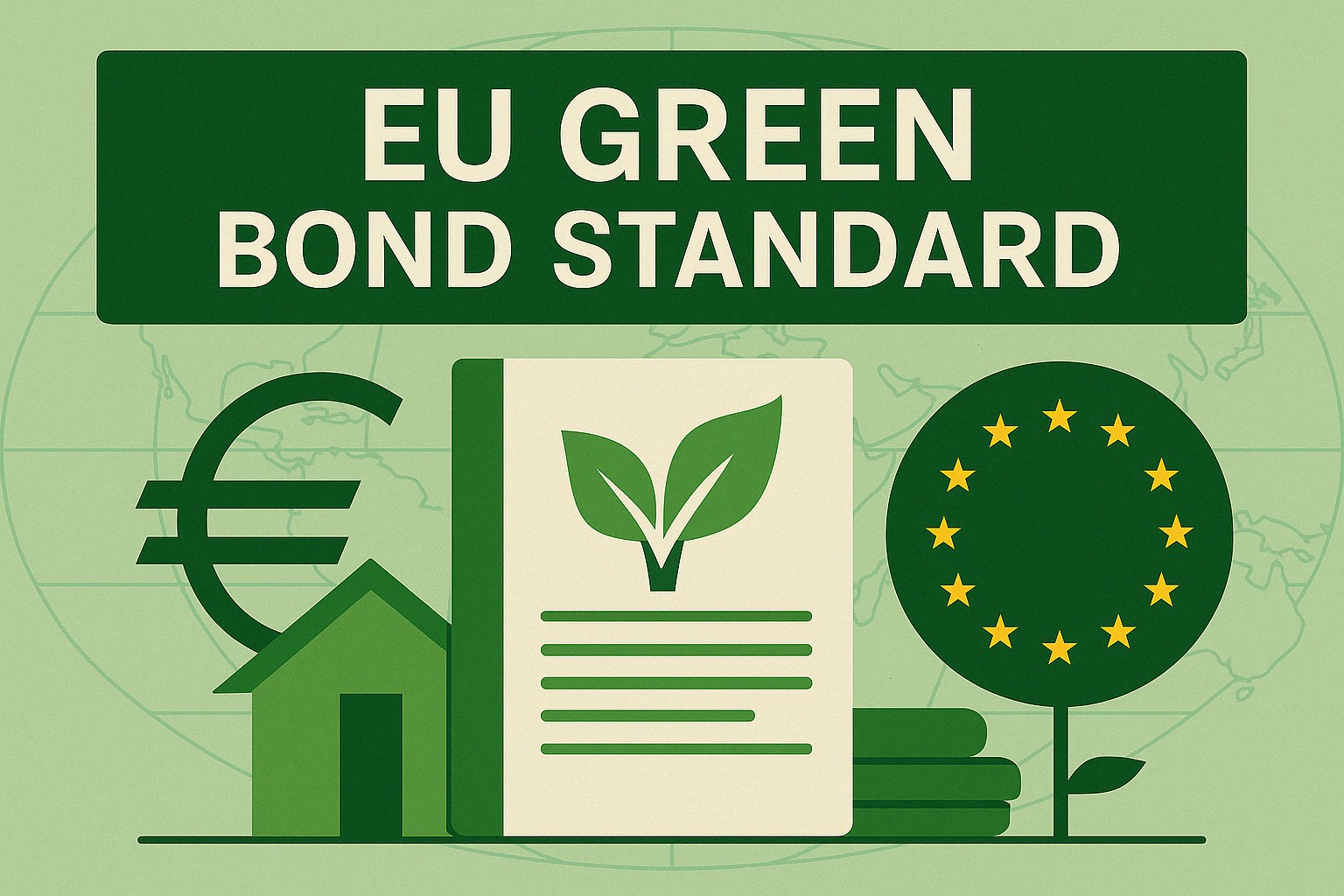The European Green Bond Standard: A New Era in Sustainable Debt
After years of growing scrutiny around greenwashing and fragmented sustainability claims in capital markets, the European Union has introduced a new regulatory milestone: the European Green Bond Standard (EuGBS). Officially adopted in November 2023 and applicable from December 2024, the EuGBS offers a voluntary but rigorous framework aimed at restoring trust and comparability in the rapidly expanding green bond market.
Designed to serve as a “gold standard,” the EuGBS is not just a set of recommendations—it’s a structured regulatory architecture. At its core is the principle of full alignment with the EU Taxonomy Regulation, tying green finance to a legally defined system of environmental objectives and safeguards. Under the EuGBS, 100% of the bond’s net proceeds must be allocated to projects that meet strict criteria for environmental contribution, “Do No Significant Harm” assessments, and minimum social safeguards. A narrow flexibility pocket allows up to 15% of proceeds to go toward activities that lack taxonomy criteria—if those still meet overarching safeguards and are transparently disclosed. This final part is a noteworthy inclusion to the standard, and it will be interesting to see how different issuers will utilize it.
The process begins before issuance, with a mandatory European Green Bond Factsheet. This detailed, standardized document includes a wide range of information, including the bond’s name, ISIN, sustainability rationale, project categories, taxonomy alignment, and plans for post-issuance reporting. More than just marketing material, the factsheet is a precondition for labeling a bond as EuGB-compliant.
Once prepared, the factsheet must be reviewed by an ESMA-registered external verifier. This mandatory pre-issuance review is a critical gatekeeper function—far more formal than the second-party opinions typically seen under the ICMA Green Bond Principles. Reviewers must confirm both the factual accuracy and regulatory compliance of the factsheet, and they operate under EU oversight, with potential sanctions for misconduct.
But the standard doesn’t stop at issuance. The EuGBS embeds transparency into the entire bond lifecycle. Issuers are required to produce annual allocation reports until proceeds are fully disbursed and publish at least one impact report detailing environmental outcomes. These reports, too, must often be externally reviewed, ensuring ongoing accountability and comparability across the market.
A defining innovation of the EuGBS is the legal integration of these sustainability commitments. The issuer’s prospectus must explicitly reference its status as a European Green Bond, outline use-of-proceeds criteria, and point investors to the factsheet and external review. This shift marks a departure from voluntary green bond frameworks, embedding green promises directly into the legal terms of the bond.
In essence, the EuGBS raises the bar on what constitutes a credible green bond in Europe. It offers a new path for issuers willing to embrace higher scrutiny and greater transparency—and provides investors with a structured, trustworthy framework to guide sustainable capital allocation. While voluntary, the EuGBS sets a clear direction: Sustainable Finance in the EU is moving from principle to policy, and from promises to performance.
A2A’s Green Bond: A Blueprint for EU GB Compliance?
In January 2025, Italian utility company A2A stepped into financial history as the first issuer to launch a bond under the European Green Bond Standard (EuGBS). This €500 million, 10-year issuance marked a significant turning point—not only for the company, but for the entire European Sustainable Finance market. Through meticulous planning and a structured compliance strategy, A2A set a precedent for how this rigorous new standard can be translated from legal text to market reality.
A2A’s journey began well in advance of the bond launch. In July 2024, the company revised its Sustainable Finance Framework, aligning it with the ICMA Green Bond Principles and securing a Second Party Opinion from S&P Global. This foundation outlined eligible project categories—renewables, energy efficiency, pollution control—and embedded commitments to EU Taxonomy alignment. In effect, A2A had laid the groundwork to meet the EuGBS before the regulation even took force.
At the core of the issuance was the European Green Bond Factsheet—a comprehensive pre-issuance disclosure document required under EuGBS. A2A’s factsheet followed the EU template precisely. It detailed the bond’s ISIN, eligible use-of-proceeds categories, environmental objectives, and how funds would be allocated across green initiatives. The company committed 100% of proceeds to projects fully aligned with the EU Taxonomy, forgoing even the 15% flexibility pocket allowed under the regulation. Over 80% of proceeds were earmarked for renewable energy and grid modernization, with the remainder going to pollution prevention and energy efficiency. A2A also pledged to publish an externally verified impact report once allocation was complete.
The factsheet alone wasn’t enough. To validate its contents, A2A appointed Sustainable Fitch as the external reviewer. The review confirmed that A2A’s disclosures met the full requirements of both the EuGBS and the EU Taxonomy. A follow-up review a few weeks later reiterated this compliance and added that the bond also met ICMA Green Bond Principles—providing the market with reassurance that the new regulatory structure aligned with existing voluntary norms. With this dual verification, A2A presented a rare level of transparency and trust.
Perhaps the most distinctive feature of A2A’s approach was the formal embedding of EuGBS obligations into its legal prospectus. The bond was issued off the company’s EMTN program, and A2A worked with Italian and Luxembourg regulators to amend the documentation to include the new requirements. This integration meant that the sustainability promises—taxonomy alignment, reporting, external reviews—became part of the legal contract with investors. The prospectus explicitly referenced the EuGBS, ensuring these commitments had regulatory weight and accountability.
A2A’s issuance wasn’t just an exercise in compliance. It demonstrated how a prepared, forward-looking issuer could meet high regulatory standards without compromising market attractiveness. By translating every facet of the EuGBS—from documentation to governance—into practice, A2A created a functional template that others in the market can now study and adapt. In doing so, it turned a complex regulation into a credible, operational bond—and arguably launched a new era in European sustainable debt.
Comparing Standards: A2A’s EuGB vs. Traditional Green Bonds
In January 2025, A2A became the first issuer to bring the European Green Bond Standard (EuGBS) to market. While this landmark bond adhered to familiar Sustainable Finance principles, it also introduced a new level of regulatory oversight and documentation. At a glance, the structure resembled prior green bonds issued under the ICMA Green Bond Principles (GBP). But a closer look reveals important distinctions—particularly in how rigor, regulatory accountability, and disclosure are defined and enforced.
Both EuGBS and GBP share foundational elements. They emphasize the exclusive use of proceeds for environmental projects, with frameworks built on four central pillars: use of proceeds, project evaluation and selection, management of proceeds, and reporting. A2A’s EuGB reflected all of these. The bond’s proceeds were fully earmarked for renewable energy, grid modernization, and waste infrastructure—all defined within A2A’s updated Sustainable Finance framework. The company had longstanding practices for internal tracking of proceeds and reporting mechanisms, aligning with expectations under GBP. Sustainable Fitch, in its post-issuance review, confirmed that the EuGB also met all four GBP pillars. In that sense, the bond was a natural evolution—not a reinvention.
However, EuGBS moved beyond principles into regulation. Whereas GBP leaves it to the issuer to define what constitutes a green project, the EuGBS mandates alignment with the EU Taxonomy. This transforms what had been a market norm into a legal requirement. A2A’s bond could not merely appear green—it had to prove it. Each project funded by the bond was evaluated for a “substantial contribution” to environmental objectives, compliance with “Do No Significant Harm” principles, and minimum social safeguards. The company did not use the 15% flexibility allowance permitted under EuGBS, choosing instead to ensure full taxonomy alignment across its entire portfolio.
This rigorous standard came with added external scrutiny. While GBP encourages Second Party Opinions, EuGBS mandates external verification. And it doesn’t stop at issuance. Reviewers, like Sustainable Fitch in A2A’s case, must be registered with ESMA and follow defined protocols. A2A’s factsheet was reviewed line-by-line for compliance with Annex I of the regulation. The review itself became part of the regulated bond package—no longer a marketing tool, but a compliance document.
Perhaps the most tangible shift introduced by EuGBS lies in legal integration. Under GBP, the green bond framework typically lives outside of the bond’s prospectus. EuGBS requires the issuer to embed sustainability commitments directly into legal bond documentation. For A2A, this meant amending its EMTN prospectus to reflect EuGB compliance, taxonomy alignment, and post-issuance obligations. These commitments, now on record with regulators like CONSOB and CSSF, transformed voluntary practices into binding investor disclosures.
Disclosure was also deeper. EuGBS demanded a standardized factsheet, spanning more than ten pages in A2A’s case. This went far beyond a typical investor presentation or framework summary. A2A had to connect each project to EU Taxonomy criteria and outline how the bond aligned with its broader decarbonization strategy. This strategic linkage—how the bond advanced A2A’s transition goals—was something GBP frameworks rarely require.
Post-issuance obligations under EuGBS are stricter too. A2A must publish annual allocation reports until proceeds are fully deployed and at least one impact report verified by an external reviewer. Under GBP, these reports are customary but not legally mandated. EuGBS transforms best practices into obligations.
There is, of course, a cost to this credibility. A2A’s preparation spanned two years, requiring coordination across sustainability, legal, finance, and regulatory teams. The factsheet alone demanded exhaustive documentation and vetting. External reviews added further costs. This level of effort may be daunting for smaller issuers, raising questions about whether the EuGBS will remain a niche tool for large and experienced players.
Still, the market rewards clarity. A2A’s EuGB was oversubscribed, with strong investor interest from both ESG-focused and mainstream accounts. Investors appreciated the transparency and depth. And in a market increasingly wary of greenwashing, the EuGBS offers not just a label—but proof.
A2A’s bond shows that the gap between voluntary and regulated standards can be bridged. The EuGBS doesn’t replace GBP, but it elevates it—codifying market norms, tightening definitions, and giving investors a clearer signal of environmental integrity. For those ready to meet the challenge, the payoff may be worth it.
A Test of Confidence: How the Market Received the First EuGB
When A2A launched the first bond under the European Green Bond Standard (EuGBS) in January 2025, it was more than a financial transaction—it was a live market test of a new regulatory era in Sustainable Finance. The €500 million issue wasn’t just about green ambition; it was about gauging whether the market was ready for the added discipline, complexity, and transparency demanded by the new standard.
The initial response was resoundingly positive. A2A’s bond attracted orders totaling over €2.2 billion—nearly 4.4 times oversubscribed. This robust demand enabled the issuer to tighten pricing and deliver one of the most successful green bond deals in recent memory. Banks hailed it as a landmark moment. Investors, it seemed, were not deterred by the heightened regulatory burden—in fact, many welcomed it. The EuGB label, associated with stricter verification and full EU Taxonomy alignment, added credibility in a space often clouded by greenwashing concerns.
Indeed, confidence was a key theme. A2A reported that ESG-focused investors made up a noticeably larger share of the order book compared to their previous green bond. Analysts noted that the EuGBS, by enforcing greater standardization, could attract more conservative or cautious institutional investors—those who may have previously sat out green bond deals due to transparency concerns. For them, the EuGB was more than a label; it was a signal of authenticity.
Yet this optimism coexisted with a fair amount of skepticism. Market participants recognized the complexity of the EuGBS as a potential barrier for many issuers. The requirement to demonstrate detailed Taxonomy alignment, undergo multiple levels of review, and embed sustainability disclosures into legal documentation significantly raised the bar. A2A itself admitted the process took years of preparation, involving coordination across sustainability, risk, finance, and legal departments.
While A2A’s success validated the new standard, it didn’t mean others would immediately follow. Many potential issuers are adopting a cautious “wait-and-see” approach. Observers suggested that only issuers with strong ESG frameworks, sufficient internal capacity, and taxonomy-ready assets—such as utilities and clean transport companies—are likely to lead the early wave. Others, particularly smaller firms or those in harder-to-assess sectors, may stay on the sidelines for now.
There was also some confusion among investors. The differences between the ICMA Green Bond Principles and the EuGBS were not always well understood. For some, the EuGB label added value; for others, existing internal due diligence processes already offered sufficient comfort, regardless of regulatory designation. This raised an important question: would EuGBS bonds enjoy a tangible pricing or demand advantage in the long run, or would they become just one tier within a fragmented green bond universe?
Still, A2A’s pioneering move has already started shaping the broader conversation. Industry groups are dissecting its approach. Legal advisors are referencing its prospectus language. And regulators, having successfully overseen the first issuance, appear open to supporting others. Feedback from this deal is also fueling discussions about refining the EuGBS—clarifying taxonomy criteria, enhancing investor education, and possibly increasing the frequency of impact reporting.
In short, A2A’s debut EuGB has proven that the “gold standard” is not only achievable—it’s also marketable. But it’s clear that the journey to broader adoption will require continued regulatory dialogue, issuer support, and market maturity. The first step has been taken. Now, the rest of the market is watching.
A Blueprint in the Making: Assessing the Practicality of A2A’s EuGB
A2A’s inaugural issuance under the European Green Bond Standard stands as both a triumph and a litmus test. It proved that the regulation—long awaited and hotly debated—can indeed work in practice. By issuing a fully EuGBS-compliant bond, complete with Taxonomy alignment, legal integration, and verified disclosures, A2A offered a working model of what a “gold standard” green bond might look like in the European context.
The company’s experience offers valuable lessons. First and foremost: preparation is everything. A2A didn’t stumble into the spotlight—it spent years developing a robust sustainability strategy and an internal framework that aligned with the direction of regulation well before the EuGBS became applicable. This groundwork, along with experience issuing earlier green bonds under the ICMA principles, positioned the utility company to transition smoothly into the more rigorous EuGBS environment.
Second, A2A’s proactive engagement with regulators and external reviewers proved essential. By coordinating early with authorities in Italy and Luxembourg, and securing timely feedback on everything from prospectus language to verification procedures, A2A was able to avoid delays and meet expectations. This suggests that regulatory cooperation—rather than confrontation—will be key to future success stories under the EuGBS.
The third takeaway lies in the market response. A2A’s bond didn’t just comply with the rules—it performed well. It was heavily oversubscribed, indicating investor appetite for high-transparency instruments. Many investors appeared to welcome the additional layers of assurance, viewing them as a sign of credibility rather than red tape. If this trend holds, the EuGB label could become a market signal of integrity—one that issuers may use to differentiate themselves.
But the story isn’t without its caveats.
For smaller or less resourced issuers, A2A’s path may be out of reach—at least for now. Drafting extensive documentation, undergoing multiple external reviews, and coordinating with multiple regulatory bodies require both time and capital. And for those operating in sectors where green projects aren’t clearly taxonomy-aligned, the complexity may outweigh the perceived benefits. As it stands, the EuGBS seems best suited for larger players in clean energy, infrastructure, and transport—those with predictable pipelines and ESG capacity already in place.
Looking ahead, successful adoption will depend on fine-tuning the framework. Regulators could issue clearer guidance to reduce uncertainty. Industry groups may develop standardized templates to streamline documentation. And investors will need continued education to fully understand what sets a EuGB apart. These steps would help bring down the barrier to entry without sacrificing the standard’s integrity.
Ultimately, A2A’s debut isn’t just an individual milestone—it’s a foundational moment for the future of sustainable capital markets in Europe. It has shown that the EuGBS can be more than theory; it can be executed, embraced, and even rewarded. If the market responds by following A2A’s lead—and if regulators and stakeholders continue to refine the framework—this voluntary standard could evolve into a widely accepted benchmark. For now, A2A has set the tone. The rest of the market will decide how far, and how fast, the standard will go.


